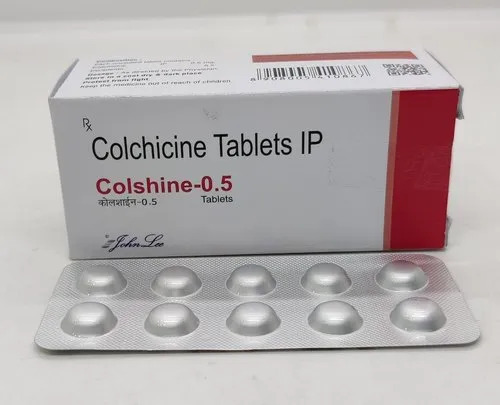
Colchicine Tablet
34.00 INR/Box
Product Details:
- Drug Type General Medicines
- Physical Form Tablets
- Dosage Guidelines As per doctor
- Quantity 1000 Pieces
- Storage Instructions Dry & Cool place
- Click to view more
X
Colchicine Tablet Price And Quantity
- 1000 Strip
- 34.00 INR/Box
Colchicine Tablet Product Specifications
- Tablets
- General Medicines
- 1000 Pieces
- Dry & Cool place
- As per doctor
Colchicine Tablet Trade Information
- MUMBAI
- 1000 Strip Per Day
- 01 Week
- Yes
- Free samples available with shipping and taxes paid by the buyer
- 10X10TAB
- Asia Australia South America Western Europe Middle East Africa Central America Eastern Europe North America
- WHO-GMP
Product Description
Colchicine tablets are a medication primarily used to treat gout and familial Mediterranean fever (FMF). They belong to the class of drugs known as anti-inflammatory agents. This short description provides key information and answers frequently asked questions about Colchicine tablets.
FAQ:
Q: What are Colchicine Tablets?
A: Colchicine tablets are a medication used to relieve symptoms and prevent flare-ups associated with gout and familial Mediterranean fever (FMF). They contain the active ingredient colchicine, which is an anti-inflammatory agent.
Q: What are the uses of Colchicine Tablets?
A: Colchicine tablets are primarily used to treat acute gout attacks, a form of arthritis characterized by severe pain, swelling, and inflammation in the joints. They can also be prescribed for the prevention of gout attacks and to manage symptoms of familial Mediterranean fever (FMF), a genetic disorder causing recurrent episodes of fever and inflammation.
Q: How do Colchicine Tablets work?
A: Colchicine tablets work by reducing inflammation and pain associated with gout and FMF. They inhibit the migration of white blood cells to the affected area, thus reducing the inflammatory response and the formation of uric acid crystals in the joints.
Q: Can Colchicine Tablets be used for other conditions?
A: Colchicine tablets are primarily indicated for gout and FMF and may not be suitable for other conditions. It is important to consult a healthcare professional to determine the appropriate treatment for any other medical conditions.
Q: How are Colchicine Tablets taken?
A: Colchicine tablets are usually taken orally with or without food at the onset of a gout attack. The initial dose is typically higher, followed by lower maintenance doses. The dosage and duration of treatment will depend on the individual's condition and response to therapy. It is important to follow the prescribed dosing instructions and not exceed the recommended dosage.
Tell us about your requirement

Price:
Quantity
Select Unit
- 50
- 100
- 200
- 250
- 500
- 1000+
Additional detail
Mobile number
Email
 English
English Spanish
Spanish French
French German
German Italian
Italian Chinese (Simplified)
Chinese (Simplified) Japanese
Japanese Korean
Korean Arabic
Arabic Portuguese
Portuguese





 Call Me Free
Call Me Free
